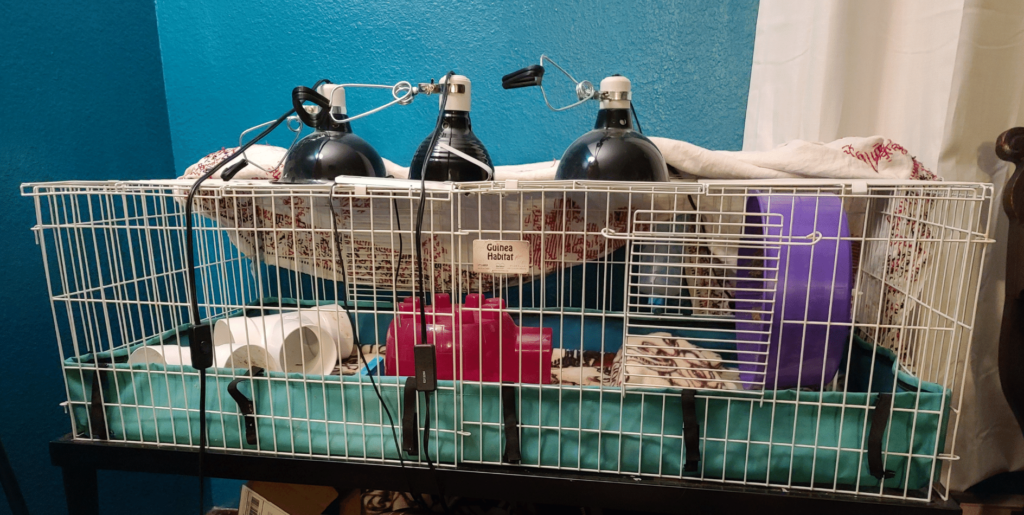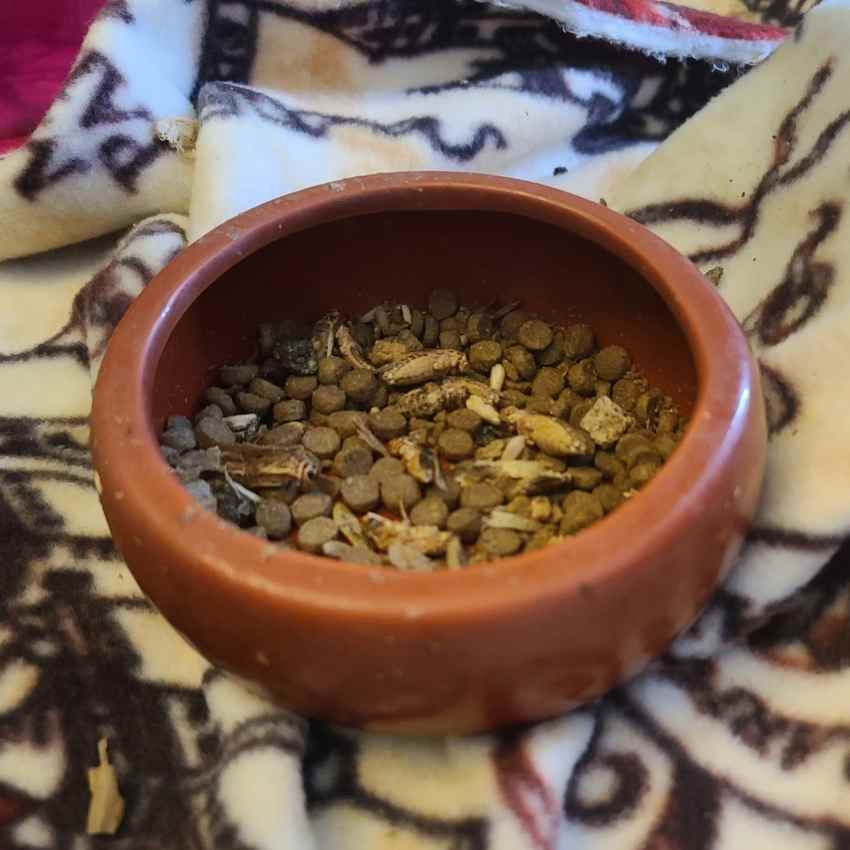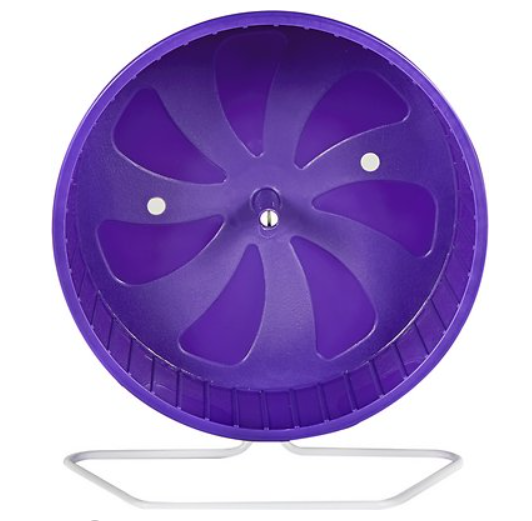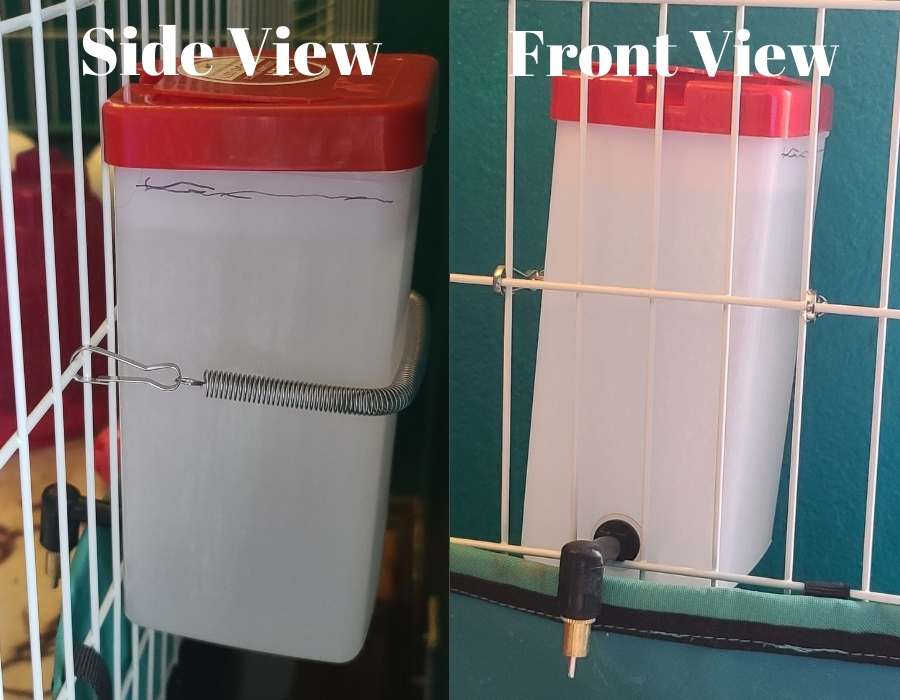So you’ve picked out the perfect cage for your new pet hedgehog, now it’s time to accessorize and decorate your pet’s home! Hedgehogs come with quite a long shopping list when compared to other small pets:
Must-Have Accessories for Hedgehogs:
- Food Bowl
- Hiding Area
- Wheel
- Water Bottle or Bowl
- Bedding
- Plenty of Room for Exercise
- Heat Source
- Thermometer
- Thermostat
This article contains affiliate links; if you purchase a product through my link it will send some spare change my way to keep this slice of the internet up and running.
It’s important to make sure the cage you choose is at least four square feet and large enough to comfortably fit everything your hedgehog needs. I highly recommend the Midwest Guinea Habitat, it’s the cage setup I currently use to house our hedgehog, Henry. It’s eight square feet and has plenty of room for all of the accessories listed above plus tons of space for your hedgehog to get exercise while exploring. It has a PVC-lined canvas bottom that’s both leak-proof and super easy to wipe down during bedding changes.

1. Hedgehog Food Bowls
Hedgehogs live up to the hog part of their name when it comes to eating, they love to root around their cage and use their nose to flip over anything and everything. Look for a heavier food dish and stay away from light plastic bowls. Some hedgehogs won’t have this issue, but the vast majority of hedgies love to constantly flip over their dishes.

I personally use a small but heavy ceramic dish. It’s heavy enough to prevent flipping attempts but short enough for easy hedgehog access.
2. Giving Your Hedgehog Somewhere to Hide
Providing your hedgehog somewhere safe and cozy to curl up to sleep or just hide out during the day is an essential part of their cage setup! You can also place a small piece of fleece inside of their hut to give them something to snuggle up with.

Plastic igloo huts are a great option for hedgehogs as they easily hold heat. The Large Kaytee Igloo is sold at most pet stores or you can also get them online. The large version is going to be big enough for any size of hedgehog and they are very easy to clean and wipe down as needed. Many pet stores offer wooden hiding huts but these are very difficult to clean. Also if your hedgehog ever has a run-in with mites (mites are one of the most common reasons for vet visits in hedgehogs) you will likely have to throw any wooden toys or huts away because they are impossible to sanitize 100%. Wooden accessories are not dangerous, they just will not last as long as a plastic igloo or hut.
3. Picking a Hedgehog Wheel
A wheel is by far the most important accessory for a hedgehog and should be at the very top of your shopping list. There are quite a few factors to take into account when purchasing a wheel so I’ve actually compiled an entire article solely about the best kinds of wheels for hedgehogs.
Most hedgehogs will fit most comfortably on a 12″ wheel and the most readily available brand is the Kaytee Comfort Small Animal Exercise Wheel. It’s sold at all big pet stores and checks all the necessary boxes. This is also the wheel I currently use with our hogs. When picking a hedgehog wheel it absolutely must be made of one solid piece. Hedgehog toes and nails can get stuck in any joints or seams; many owners have woken up to a bloody mess from a nail getting snagged in a seemingly microscopic seam.

4. Water Bottle or Bowl
You may be surprised to learn that bottles vs. bowls is a heated topic of debate in the hedgehog community! Water bottles are more sanitary than bowls and they also give you the ability to easily see how much your hedgehog is drinking each day. It’s important to choose a water bottle with a wide spout and it cannot be spring-loaded. If your hedgehog is not getting enough water on each lick of the spout they tend to get frustrated and try to chew the metal spout while trying to get even more water. This can lead to chipped teeth and is the source of most of the animosity that has been directed at water bottle usage with hedgehogs. Your hedgehogs will not try to chew the metal as long as the spout is big enough! Look for a free-flowing wide-spouted bottle.
You can also find water bottles with metal nipple style openings instead of the traditional ball bearing in a spout. These bottles have far less issues with leaking and easily let out a good amount of water on each lick. The bottle below is the one I currently use for our hogs.

If you decide to use a bowl just be aware you will need to check it throughout the day to see if bedding, food, or anything else has fallen into the water. Also as I mentioned earlier with food bowls, hedgies also love to flip water dishes so be sure to pick something on the heavier side.
5. Bedding & Heating
A proper hedgehog heating setup is one of the most important things to consider when first bringing your new pet home! You should have your cage and heating elements completely assembled and warmed up before bringing your little buddy home. If you don’t have a heater quite yet, go read my full heating setup guide here.
Choosing the right kind of bedding is a very important part of keeping your hedgehog clean and cozy. Many people (myself included) use anti-pill fleece as a liner for the bottom of the cage. You can buy anti-pill fleece at any fabric store and you can throw it in the wash once a week. You just need to get enough material to fold in half and cover the entire cage floor. I have two liners that I rotate out. If you’re not crafty you can also buy a pre-made fleece liner.
6. A Thermometer or Thermostat
Uncontrolled hedgehog cage temperatures can wildly vary from day to day. Your hedgehog’s cage should be kept 73-78 degrees. It can be very hard to regulate the temperature of the cage with just an uncontrolled heat lamp. It’s impossible to control unless you are in the room 24/7 which is most likely not the case. This is why I strongly suggest an automated cage thermostat. I use a digital thermostat to control and monitor the temperature in all of my hedgehog’s cages. You can plug your ceramic heat emitter lamp into the thermostat and it will regulate the temperature of the cage by turning the lamp on and off as needed. This feature is especially handy during the summer months if you experience drastic temperature changes between night and daytime.
I personally dangle the thermometer to about six inches above the cage floor. This is high enough that our hedgehog can’t mess with it but low enough that it will give an accurate temperature reading. CHE lamps put out a ton of warmth, but that heat gets weaker the farther away you get from the bulb. If I had the reader near the ceiling of the cage it would give a completely different reading than when I have it near the floor (where the hedgehog actually is).
Where Should I place Accessories?
It’s important to place your hedgehog’s sleeping area close to the cage’s heat source. Hedgehogs will try to hibernate if they get too cold. If they happen to fall asleep in a corner of the cage that is too cold it’s very easy for them to slip into hibernation while sleeping because of the low temperature. If you are still shopping around for heating lamps check out my in-depth hedgehog heating guide here!
Setting Up a Hedgehog Cage For The First Time
You should set up your hedgehog’s living area a few days before you bring them home for the first time. This will give you time to get everything settled and to make sure your heating setup is ready to go. Depending on your climate and how warm you keep your house it may be tough to keep your new hedgie warm while trying to set up a cage if you bring them home before things are ready.
It will also make the transfer from the breeder to your house less stressful on your new friend if they can immediately relax in their new cage instead of waiting even longer while you rush things into place.
